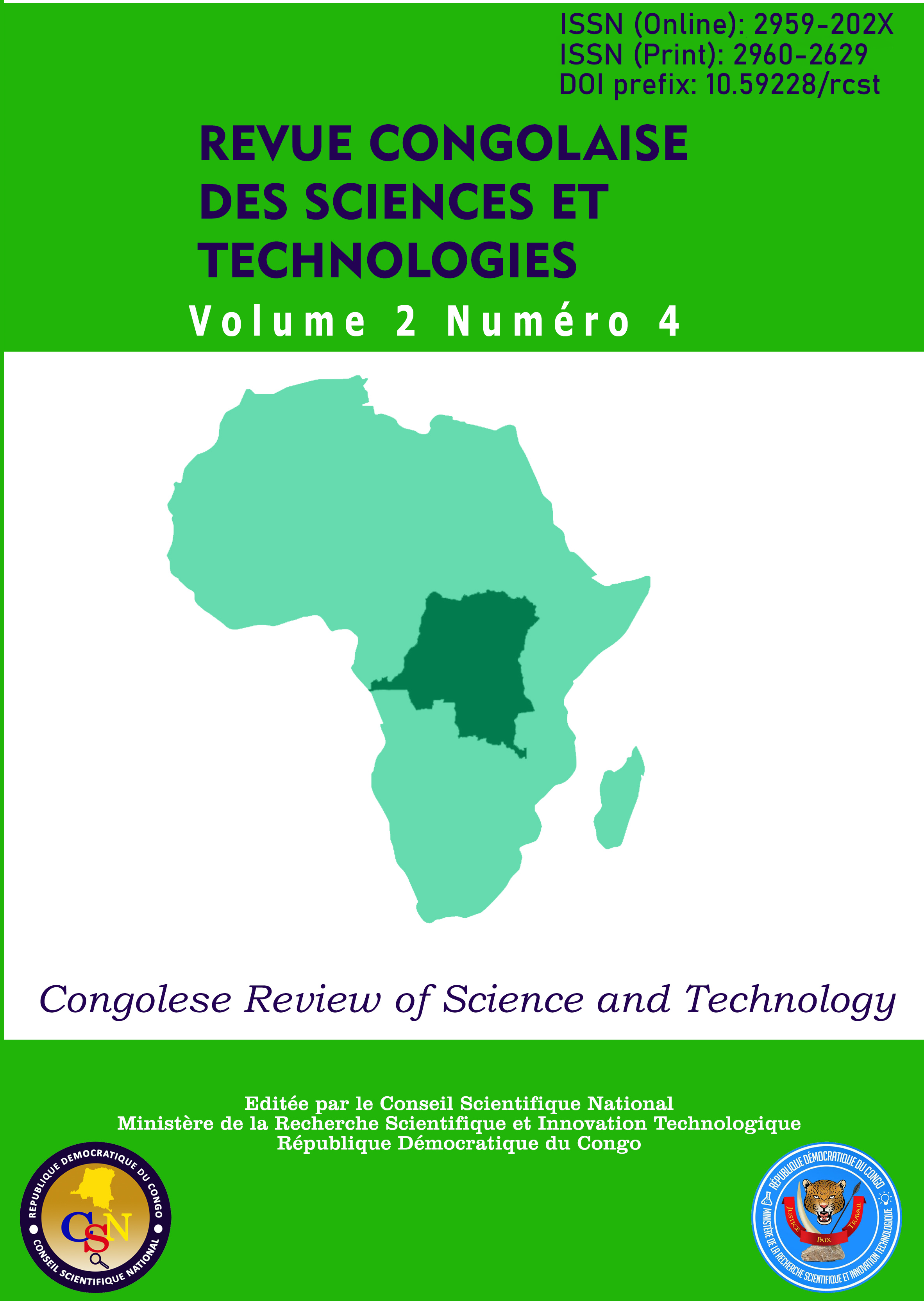Effect of acid activation on adsorption properties of some clay materials from South-East of the Democratic Republic of Congo
Main Article Content
Abstract
The effect of acid activation of some clay materials in the South-East of the Democratic Republic of Congo was studied, in
the interest of considering the substitution of imported clays as adsorbents. Depending on abundance, type of supporting soil
and accessibility in this region, six clay materials were chosen including two taken from the montmorillonite-rich soils
(Malambwe and Kasenga), one from the kaolinite-rich soil (Kazembe) and three others (Lufira, Kalubwe, and Kyowelo) taken
from soils with equivalent proportions of montmorillonite and kaolinite. Acid concentration, time, temperature and
impregnation ratio were studied during activation for which the effect was evaluated by the cation exchange capacity (CEC)
after contact with a solution of methylene blue as adsorbate. The results showed that activation did not significantly improve
the adsorbent power with increases in CEC which barely exceeded 30% with the exception of the Kazembe sample which
gave an increase of 50%. Clay materials can therefore be used without prior activation and remain competitive in this case the
samples rich in montmorillonite which gave the best CEC values of 110 mmol/100g for Malambwe and 82 mmol/100g for
Kasenga, the others having values less than 73 mmol/100g. However, these performances remain slightly lower than those of
imported clays which gave 143 and 119 mmol/100g respectively for Bentonite and Tonsil
Article Details

This work is licensed under a Creative Commons Attribution-NonCommercial-ShareAlike 4.0 International License.
References
Adams, J. M., & McCabe, R. W. (2006). Clay
Minerals as Catalysts. In F. Bergaya, B.K.G.
Theng, & G. Lagaly (Eds.), Developments in Clay Science, (pp. 541‑ 581). Amsterdam,
Elsevier. https://doi.org/10.1016/S1572-
(05)01017-2
Al Kausor, M., Sen Gupta, S., Bhattacharyya, K. G.,
& Chakrabortty, D. (2022). Montmorillonite
and modified montmorillonite as adsorbents for
removal of water soluble organic dyes : A
review on current status of the art. Inorganic
Chemistry Communications, 143, 109686.
https://doi.org/10.1016/j.inoche.2022.109686
Amari, A., Gannouni, H., Khan, M., Almesfer, M.,
Elkhaleefa, A., & Gannouni, A. (2018). Effect
of Structure and Chemical Activation on the
Adsorption Properties of Green Clay Minerals
for the Removal of Cationic Dye. Applied
Sciences, 8(11), 2302.
https://doi.org/10.3390/app8112302
Bahwa, C. & Zeka, L. (2023). Localisation des sites
d’échantillonnage de différentes argiles
étudiées (Haut-Katanga: KAS, MAL, KAL et
LUF ; Lualaba : KAZ et KYO) [Carte].
Babaki H., Salem A., Jafarizad A. (2008). Kinetic
model for the isothermal activation of bentonite
by sulfuric acid. Mater. Chem. Phys., 108, 263–
Berez, A. (2015). Dépollution par l’argile naturelle
d’effluents teinturiers : Étude expérimentale et
modélisation du processus d’adsorption /
désorption en réacteur fermé et colonne de
percolation [Thèse de Doctorat, Université de
Strasbourg].
Clauer, N. (2005, avril). Les minéraux argileux : Leur
rôle et importance dans un site de stockage de
déchets radioactifs en couche argileuse
profonde. L’actualité chimique, 285.
Crundwell, F. K., du Preez, N. B., & Knights, B. D.
H. (2020). Production of cobalt from coppercobalt ores on the African Copperbelt – An
overview. Minerals Engineering, 156, 106450.
https://doi.org/10.1016/j.mineng.2020.106450
Dudley, K., Virnig, M., Crane, P., & Hein, H. (2006).
Clay Treatment for Copper Solvent Extraction
Circuits [Communication]. Alta Conference,
Australie.
España, V. A. A., Sarkar, B., Biswas, B., Rusmin, R.,
& Naidu, R. (2019). Environmental
applications of thermally modified and acid
activated clay minerals : Current status of the
art. Environmental Technology & Innovation,
, 383‑ 397.
Fernandes, C., Catrinescu C., Castilho P., Russo P.A.,
Carrott M.R., Breen C., (2007). Catalytic
conversion of limonene over acid activated
Serra de Dentro (SD) bentonite, Appl. Catalysis
A: Gen. 318 ,108–
https://doi.org/10.1016/j.eti.2016.11.005
Gannouni, A. & Bellagi, A. (2001). Activation acide
de quelques argiles du sud tunisien I.
Préparation de terres décolorantes pour huiles
végétales. Journal de la société chimique de
Tunisie, 4(10) 1357-1368.
Hussin, F., Aroua, M. K., & Daud, W. M. A. W.
(2011). Textural characteristics, surface
chemistry and activation of bleaching earth : A
review. Chemical Engineering Journal, 170(1),
‑ 106.https://doi.org/10.1016/j.cej.2011.03.0
Hutzler, B., Cole, P., Thomas, L., Bednarski, T., &
Zambra, R. (2015). Clay Treatment
Improvements Using ACORGA® CB1000 Clay
Binder [Communication]. Southern African
Institute of Mining and Metallurgy, Copper
Cobalt Africa 8th Base Metal Conference,
Joannesbourg.
Kabumana, D. T., Twite, E., Twite, P., Kanyembo,
A., & Lubamba, J. (2020). Evaluation of the
performance of a local acid activated clay on
the decontamination of solvent extraction plant
organic. Journal of Applied Chemistry, 13(5),
‑ 53.
Kaviratna, H., & Pinnavaia, T.J. (1994). Acid
hydrolysis of octahedral Mg2+ sites in 2:1
layered silicates: an assessment of edge attack
and gallery access mechanisms. Clays Clay
Miner., 42, 717–723.
Khan, W. S., Asmatulu, E., Uddin, Md. N., &
Asmatulu, R. (2022). Recycling and reusing of
used lubricating oils. In W.S. Khan, E.
Asmatutu, M. Uddin & R. Asmatulu (Eds.),
Recycling and Reusing of Engineering
Materials (p. 213‑ 232). Amsterdam, Elsevier.
https://doi.org/10.1016/B978-0-12-822461-
00010-3
Koller, E. (2010). Aide-mémoire Génie chimique (3è
éd). Paris, Dunod.
Konrad, J.-M., & Gabezas, F. A. V. (2008).
Caractérisation des particules fines d’un
matériau granulaire de fondation par l’essai au
bleu de méthylène [Rapport de recherche,
Université Laval].
Madejová J., Bujdák J., Janek M., Komadel P.
(1998). Comparative FT-IR study of structural
modifications during acid treatment of
dioctahedral smectites and hectorite,
Spectrochim. Molecular and Biomolecular
Spectroscopy, 54, 1397-1406.
https://doi.org/10.1016/S1386-1425(98)00040-
Mukherjee, S., & Ghosh, B. (2013). The science of
clays : Applications in industry, engineering
and environment. Dordrecht, Springer.
Ngongo, M. L., Van Ranst, Baert, G., Kasongo, E.,
Verdoodt, A., Mujinya, B., & Mukalay, J.
(2009a). Guide des sols en République Démocratique du Congo. Tome I: étude et
gestion (Vol. 1). Lubumbashi, Don Bosco.
Ngongo, M. L., Van Ranst, Baert, G., Kasongo, E.,
Verdoodt, A., Mujinya, B., & Mukalay, J.
(2009b). Guide des sols en République
Démocratique du Congo. Tome II: description
et données physicochimiques (Vol. 1).
Lubumbashi, Don Bosco
Shengo, M. L., Kime, M.-B., Mambwe, M. P., &
Nyembo, T. K. (2019). A review of the
beneficiation of copper-cobalt-bearing minerals
in the Democratic Republic of Congo. Journal
of Sustainable Mining, 18(4), 226‑ 246.
https://doi.org/10.1016/j.jsm.2019.08.001
Srasra, E. (2002). Argile et acidité. Mécanisme de
l’activation acide et propriétés résultantes
[Thèse de Doctorat, Univesrité de Tunis].
Sole, K. C. (2016). Copper solvent extraction : Status,
operating practices, and challenges in the
African Copperbelt. Journal of the Southern
African Institute of Mining and Metallurgy,
(6), 553‑ 560.
https://doi.org/10.17159/2411-
/2016/v116n6a10
Valenzuela-Diaz F.R., Souza-Santos P. (2001).
Studies on the acid activation of Brazilian
smectite clays. Quim. Nova., 24,345–353.
Vernhet, A. (2019). Red Wine Clarification and
Stabilization. In A. Morata (Ed), Red Wine
Technology (p.237‑ 251). Amsterdam,
Elsevier. https://doi.org/10.1016/B978-0-12-
-5.00016-5
Wetshondo, D. (2012). Caractérisation et
valorisation des matériaux argileux de la
Province de Kinshasa (RD Congo) [Thèse de
Doctorat, Université de liège].
Wypych, F., & de Freitas, R. A. (2022). Clay
minerals : Classification, structure, and
properties. In F. Wypych & R. A. de Freitas
(Éds.), Developments in Clay Science (Vol. 10,
p. 3‑ 35). Amsterdam, Elsevier.
https://doi.org/10.1016/B978-0-323-91858-
00004-5

